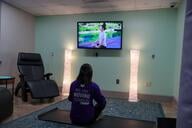You have /5 articles left.
Sign up for a free account or log in.
A display at the 2024 Active Minds Conference in Washington, D.C., encourages visitors to leave a note of encouragement or support for individuals struggling with suicidal ideation or other mental health concerns. Send Silence Packing is one of Active Minds’ messaging campaigns to encourage college students to talk about mental health concerns.
Ashley Mowreader/Inside Higher Ed
College students are reporting greater mental health concerns today than ever before, which includes suicidal ideation. Supporting holistic student success on college campuses involves suicide prevention work.
Suicide prevention month, recognized each September, is an opportunity for colleges and universities to provide intentional programming and education around mental health, self-harm and other risk factors for death by suicide.
What’s the need: In 2022, around 13.6 young people (ages 15 to 23) per 100,000 died by suicide. Youth suicide (ages 10 to 24) declined 8.4 percent from 2021 to 2022. Suicide is considering a leading cause of death in the United States, among all adults, with one death every 11 minutes.
LGBTQ+ youth report higher risk of suicidal ideation, with recent data from the Trevor Project finding 39 percent of LGBTQ+ young people seriously considered and 12 percent attempted suicide in the past year.
Four interventions that positively and proactively engage college students in suicide prevention work follow.
Sean’s House
Named after Sean Locke, a University of Delaware graduate who died by suicide in 2018, Sean’s House is an off-campus facility that provide suicide prevention and support to students at the institution. The house was Locke’s residence while he was a student.
The space is free for all young adults ages 14 to 24 and offers 24-7 support for mental health challenges. Resources include one-on-one meetings and community groups for different demographics, including parents, LGBTQ+ young people and survivors of suicide loss.
Sean’s House is staffed by mental health professionals plus other young people, many of whom are UD students, who serve as peer specialists.
Since opening in 2020, the facility has had over 30,000 visitors, hosted over 4,250 peer support sessions and served in 122 active crises, according to the Sean’s House website.
Send Silence Packing
Send Silence Packing is a traveling exhibit and immersive experience organized by Active Minds that brings awareness to suicide on college campuses. The exhibit was first displayed on the National Mall in Washington, D.C., in 2008, and most recently, the exhibit took place at Ohio University on Sept. 3. Since launching, over 300 communities have benefited from the exhibit.
The display features 100 backpacks, each associated with someone who died by suicide and their story (reviewed and revised by Active Minds personnel in accordance with public health practices to reduce harm). After walking past the racks of backpacks, visitors can engage with an immersive audio experience, visit a resource tent or contribute to a Hope Wall of encouraging messages. Mental health professionals are also available on-site to aid as needed.
The campaign encourages people to seek out resources for themselves, friends or loved ones. Postsurvey data shows the exhibit is powerful and educational, encouraging people to talk about suicide prevention and seek support if they need it.
Student ID Support
Recent legislation in Virginia, passed in March, requires all public institutions of higher education to include an emergency QR code on student identification cards.
Seeking Help
If you are in crisis, please call, text or chat with the Suicide and Crisis Lifeline at 988, or contact the Crisis Text Line by texting TALK to 741741.
Each QR code links to emergency support resources including a suicide hotline, sexual assault support and campus police services. Advocates hope having the QR code on hand and readily available when students are in crisis can help make them more aware and likely to use resources.
In August, New York legislators passed a bill to add suicide prevention hotline numbers to ID cards for college students in that state as well.
Out of the Darkness Campus Walks
Each spring the American Foundation for Suicide Prevention (AFS) hosts fundraising 5K walks for youth and young adults to join suicide prevention efforts. Each donation helps with research, education, support and advocacy in suicide prevention work.
California State University, Sacramento, hosted a campus walk in April, organized by Student Health and Counseling Services, Active Minds Sacramento State and AFS, which included more than 1,000 people. During the event, participants learned about crisis hotlines, domestic violence resources and counseling services, and they were able to engage with therapy dogs. The University of Arkansas at Little Rock also hosted a walk this past April, which included a free brunch, therapy dogs, live music, a drum circle, a bounce house, giveaways and speakers.
Do you have a wellness tip that might help others encourage student success? Tell us about it.




